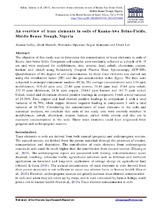| dc.description.abstract | The objective of this study was to determine the concentration of trace elements in soils of Keana-Awe brine-fields. Composite soil samples were randomly collected at a depth of 0–15 cm and were analysed for molybdenum, zinc, arsenic, lead, cobalt, chromium, copper, barium and nickel using Inductively Coupled Plasma Mass Spectroscopy (ICP-MS). Quantification of the degree of soil contamination by these trace elements was carried out using the enrichment factor (EF) and the geo-accumulation index (Igeo). The data were subjected to principal component analysis (PCA). The average concentrations were 1.56 ppm molybdenum, 1116.42 ppm zinc, 23.80 ppm arsenic, 71.40 ppm lead, 17.64 ppm cobalt, 237.35 ppm chromium, 24.16 ppm copper, 254.67 ppm barium and 143.71 ppm nickel. Cobalt, nickel and chromium showed positive loadings in component 1 with a total variance of 29.56%. Zinc, copper and lead showed positive loadings in component 2 with a total variance of 18.79%, while copper showed negative loading in component 3 with a total variance of 14.79%. Considering the concentration of trace elements in the soils and statistical analyses, we conclude that soils of the study area were severely enriched in molybdenum, cobalt, chromium, copper, barium, nickel, while arsenic and zinc are in excessive concentrations in the soils. These trace elements could have originated from geogenic and anthropogenic sources. | en_US |

